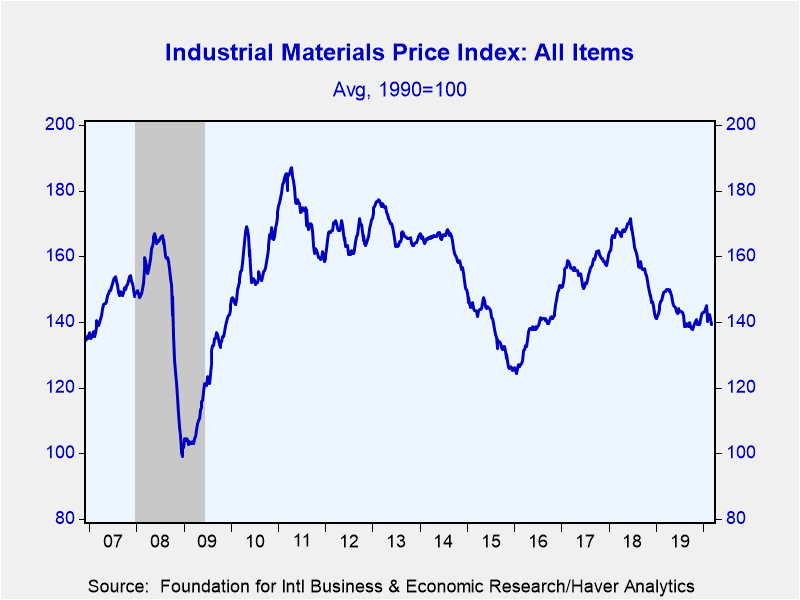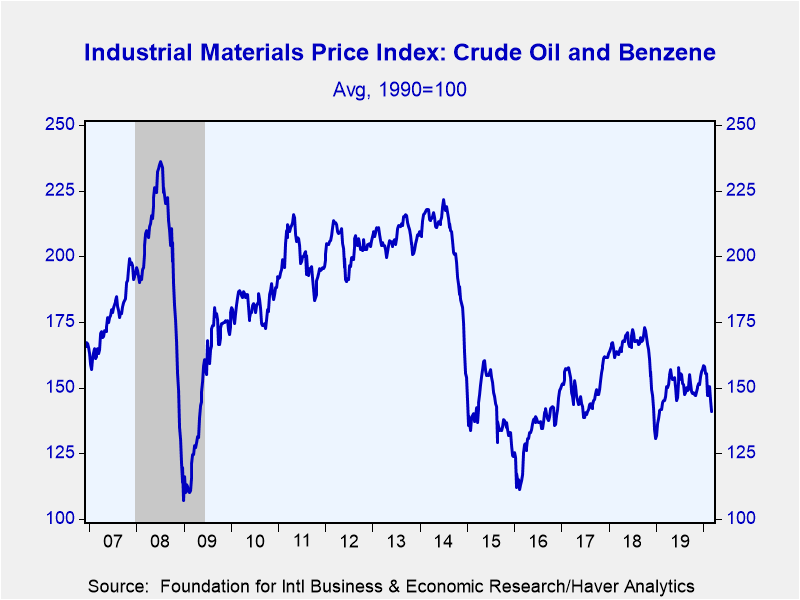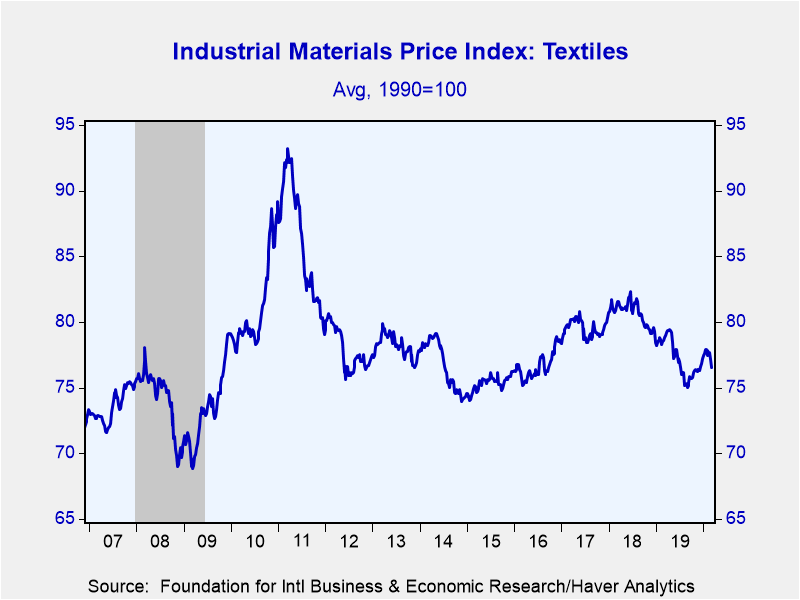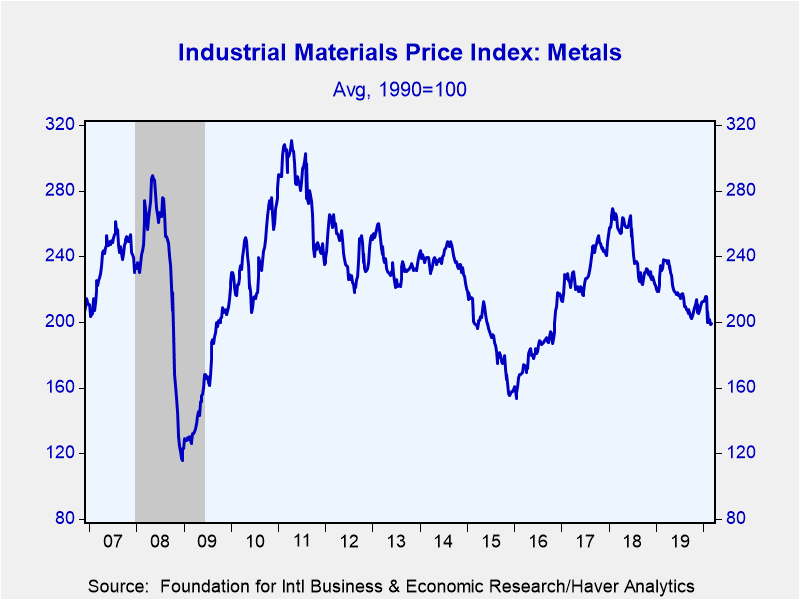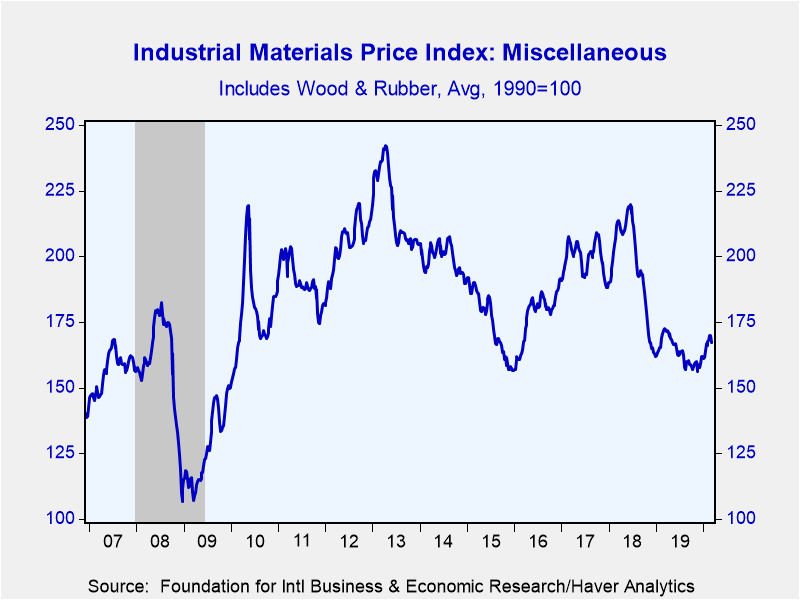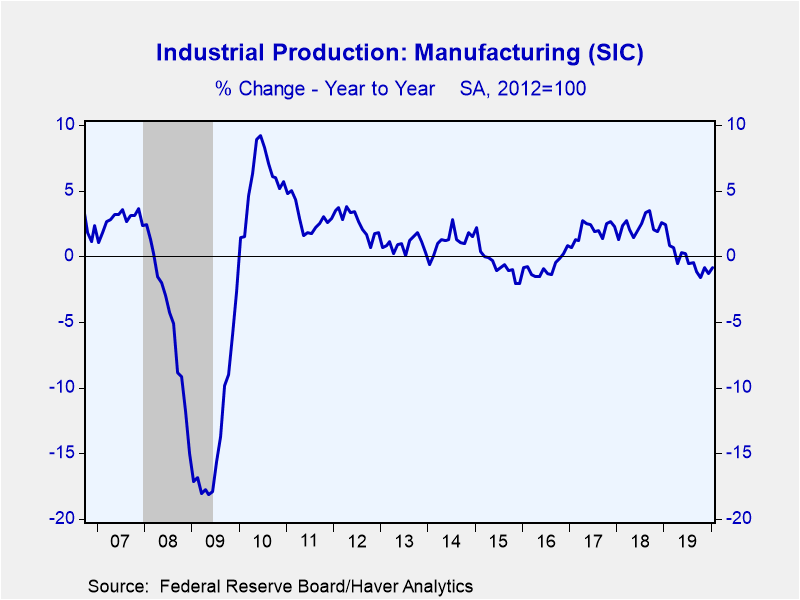 Global| Mar 09 2020
Global| Mar 09 2020FIBER: Industrial Commodity Prices Weaken Ahead of Oil Price Collapse
by:Tom Moeller
|in:Economy in Brief
Summary
The Industrial Materials Price Index from the Foundation for International Business and Economic Research (FIBER) declined 0.9% during the four weeks ended Friday and 6.8% over the last year. The price index fell to the lowest level [...]
The Industrial Materials Price Index from the Foundation for International Business and Economic Research (FIBER) declined 0.9% during the four weeks ended Friday and 6.8% over the last year. The price index fell to the lowest level since the third week of October, down 4.0% since the end of January.
Prices in the crude oil & benzene group declined 4.2% during the last four weeks as WTI crude oil prices weakened to $45.58 per barrel on Friday, down from a high of $61.75 eight weeks earlier. Today, prices declined by roughly $10.00 per barrel to the lowest price since early-2016. Prices of petro-chemical benzene fell 2.9% in the last four weeks (+24.6% y/y) and reversed gains made since late last year. Excluding crude oil, industrial commodity prices eased 0.3% during the last four weeks and were off 6.1% over the last year.
Textile also weakened 1.1% versus February led by an 8.6% four-week drop in cotton prices to the lowest level since last summer. This decline was countered by a 2.7% rise (-2.2% y/y) in the cost of burlap. Metals prices eased 0.5% over four weeks as zinc prices fell 9.8% (-28.7% y/y) and extended their declines since the early-2018 high. Lead prices also softened. Copper scrap prices weakened 0.5% during the last month. Countering these declines was a 4.0% improvement in steel scrap prices, though they remained well below the 2018 highs. The cost of aluminum was little changed over the last four weeks at the late-2016 low. Prices in the miscellaneous group improved 0.7% over four weeks as the cost of natural rubber strengthened 7.8%. Working the other way, framing lumber prices declined 5.5% over that period. Plywood prices held steady but were 14.0% lower over the course of the last year.
Weakness in industrial commodity prices continues to reflect a struggling U.S. factory sector. Output eased 0.1% in January, reversed December's increase and fell 0.9% y/y. During the last ten years, there has been a 65% correlation between the y/y change in industrial commodity prices and the y/y change in factory sector production.
Commodity price data can be found in Haver's DAILY, WEEKLY, USECON and CMDTY databases. The NABE forecast is in the SURVEYS database.
| FIBER Industrial Materials Price Index (%) | 1-Mth | 3-Mth | 6-Mth | 12-Mth | 2019 | 2018 | 2017 |
|---|---|---|---|---|---|---|---|
| All Items | -0.9 | -0.1 | 0.2 | -6.8 | 1.1 | -12.0 | 6.7 |
| Excluding Crude Oil | -0.3 | 1.1 | 1.3 | -6.1 | -0.6 | -11.1 | 4.9 |
| Textiles | -1.1 | 0.3 | 1.8 | -2.9 | -1.6 | -2.8 | 3.0 |
| Cotton (cents per pound) | -8.6 | -4.2 | 5.3 | -15.6 | -6.6 | -9.2 | 9.8 |
| Metals | -0.5 | -3.9 | -3.0 | -16.3 | -4.3 | -12.2 | 18.6 |
| Aluminum ($ per metric ton) | 0.2 | -4.6 | -1.8 | -8.8 | -6.5 | -12.7 | 26.0 |
| Copper Scrap (cents per pound) | -0.4 | -3.7 | -0.4 | -13.5 | 3.5 | -16.1 | 29.3 |
| Steel Scrap ($ per ton) | 4.0 | -1.9 | 5.1 | -14.5 | -0.8 | 2.3 | 16.8 |
| Crude Oil & Benzene | -4.2 | -6.7 | -5.6 | -2.9 | 20.2 | -20.0 | 8.1 |
| Crude Oil (WTI, $ per Barrel) | -9.4 | -18.3 | -16.4 | -17.4 | 35.5 | -24.4 | 10.9 |
| Miscellaneous | 0.7 | 6.2 | 4.6 | -2.9 | -0.0 | -14.8 | -0.5 |
| Framing Lumber ($ per 1000 board ft.) | -5.5 | -0.7 | 15.4 | 7.0 | 22.6 | -23.1 | 20.0 |
| Natural Rubber (cents per pound) | 7.8 | 5.2 | 4.9 | -5.0 | 10.7 | -4.1 | -29.6 |
Tom Moeller
AuthorMore in Author Profile »Prior to joining Haver Analytics in 2000, Mr. Moeller worked as the Economist at Chancellor Capital Management from 1985 to 1999. There, he developed comprehensive economic forecasts and interpreted economic data for equity and fixed income portfolio managers. Also at Chancellor, Mr. Moeller worked as an equity analyst and was responsible for researching and rating companies in the economically sensitive automobile and housing industries for investment in Chancellor’s equity portfolio. Prior to joining Chancellor, Mr. Moeller was an Economist at Citibank from 1979 to 1984. He also analyzed pricing behavior in the metals industry for the Council on Wage and Price Stability in Washington, D.C. In 1999, Mr. Moeller received the award for most accurate forecast from the Forecasters' Club of New York. From 1990 to 1992 he was President of the New York Association for Business Economists. Mr. Moeller earned an M.B.A. in Finance from Fordham University, where he graduated in 1987. He holds a Bachelor of Arts in Economics from George Washington University.


